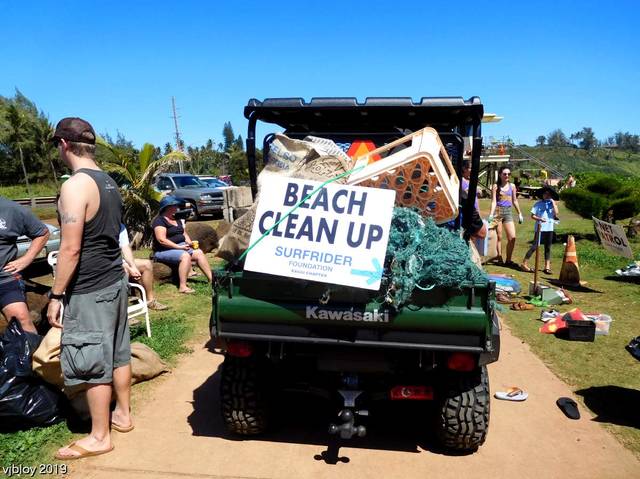KAPAA — About 200 volunteers removed more than 4,000 pounds of plastics, nets and other marine debris from Kauai’s East Side shores on Saturday through a cleanup hosted by B-RAD Foundation and Surfrider Kauai Chapter.
It’ll add to the 10,000 pounds of marine debris collected monthly from Kauai’s shores.
That debris is made up of plastic pieces and random trash that’s drifted in, cigarette butts and bottle caps discarded on the beaches, and derelict vehicle parts; but the bulk of what lands on Kauai is gear from one industry — commercial fishing.
In fact, nets, buoys and other discarded or lost fishing gear make up about 85 percent of the debris collected from Kauai, according to Barbara Weidner, one of the Surfrider coordinators of net patrol and beach cleanups.
“There’s one right now over at Kahili Beach (Rock Quarry),” Weidner said.
While she didn’t have the exact weight readily available, Weidner said she anticipates that net will fill about five pickup beds to the brim before it’s been recovered from the beach.
It’s a familiar story for residents and visitors who donate their time to clean the beaches — and an all too familiar feeling for those people when they return to find the place they cleaned full of trash the next day.
“It’s not stopping,” Weidner said.
But those nets — which can reach and surpass 5,000 pounds — don’t just come from around Kauai. Nets, buoys and other gear can float in from places like Alaska after being what is considered “ghost gear” for months or years in the open ocean.
And sometimes they aren’t floating in by themselves.
On Feb. 22, a humpback whale was reported entangled in some line, a buoy and a trap off the coast of Maui, and officials are still searching for that whale after being able to cut a small amount of the debris away.
“A major part (of the gear) is still on that animal,” said Ed Lyman, large whale entanglement response coordinator for the National Oceanic and Atmospheric Administration on Monday. “We were able to get some off of it.”
The gear removed was analyzed and its origin pinpointed to the Alaskan humpback whale feeding areas and responders are now working with those local authorities to further distill information about the gear.
The whale itself is still at large, and still presumably dragging a 3-foot trap about 100 feet below the animal.
All of that gear, Lyman says, was most likely active gear that was in use when the whale was entangled — based on its condition. But, that active gear is just part of the commercial fishing industry’s ocean debris — the other type floating around the ocean is ghost gear.
Ghost gear is a term for nets, traps, and other gear that’s been abandoned or lost at sea; the stuff that lingers in the ocean long after the vessel has left, catching animals and snagging on reefs as it moves through the currents.
“I would argue that anything that entangles a whale is marine debris at that point,” Lyman said.
About 705,000 tons of ghost gear are discarded annually into the world’s oceans, according to a 2018 study out of London’s World Animal Protection.
That’s a problem Weidner and other Surfrider volunteers would like to see addressed, and one that Weidner herself will be speaking about starting today on Capitol Hill.
“I’m going to Washington D.C. to talk to elected officials and go lobby,” Weidner said Monday. “In 2018, plastic in the ocean was all over the news, we really want to talk about the nets (specifically).”
•••
Jessica Else, environment reporter, can be reached at 245-0452 or at jelse@thegardenisland.com







Its amazing how selfish the world has got just turning a blind eye to recycling, theirs a bigger picture here that is why i started a waste recycling company we try to divert almost everything from going to landfill its just scary what people are will to throw away. https://www.kekewastedisposal.co.uk